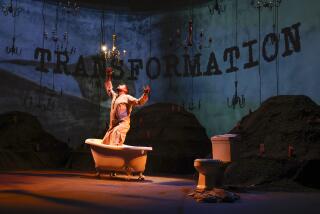City of Caves on a Comeback
MATERA, Italy â âAt night,â a 16th century visitor wrote, âall the inhabitants of the city set their lamps outside their homes; to one looking down from the plateau, the sassi [cave dwellings] shine like a starry sky.â
In the 1930s, the sister of writer Carlo Levi looked into the same caves and was appalled by the human misery she saw. Children ravaged by starvation and cholera, she told him, begged her for quinine, not candy.
Today, Matera has put its various pasts behind and is an affluent provincial city of 56,000 capitalizing on the cave quarters for tourism.
Matera is in the barren, sun-bleached hills of Basilicata, the region that lies on the arch of Italyâs boot. The ancient seaport of Bari is only a 1 1/2-hour drive away; Naples is 2 1/2 hours on the superhighway. But until the automobile age, Matera was a world of its own.
Coming in through the outskirts of the modern upper town, you pass the new university, streets of apartment blocks, austere public buildings from the Fascist era. Closer to the center, where there are many fine churches and religious buildings, baroque predominates. At the cityâs heart is the Piazza Vittorio Veneto, crowned by an impressive former convent that now houses a movie theater. (Leonardo di Caprio in âThe Man in the Iron Maskâ was the draw when I was there last April.)
The piazza is the starting point for exploring the city of caves on which modern Matera rests.
Armed with a map from the tourism office around the corner, I cross the piazza for a look at the sassi--the word means âstonesâ--below. There are two of these neighborhoods carved out of the walls of a broad ravine that extends like arms on either side of the cathedral. One, Sasso Caveoso, is visible from the upper city; the other, Sasso Barisano, lies on the far side of the cathedralâs rocky perch.
In contrast to the upper town, with its grand buildings and open spaces, the sassi are an architectural jumble. Houses--rather, the facades of houses--seem to be stacked one on top of the other, flush to the hillside. Behind them are caves made into dwellings, caves for churches, caves for tradesmen. It takes some time to discern the access to them, the paths, patios and small piazzas that wind around terraced niches and across the tops of roofs.
The sassi glow in the late afternoon sun. A dog barks. An ant trail of tourists picks its way up a narrow street of stairs. It all wears the abandoned air of an Italian hill town at siesta.
If you came here knowing nothing of Matera and its history, it might take you a moment to realize that the air of abandonment is no illusion: These houses have stood empty for nearly 50 years.
After World War II, more than 15,000 people lived here, without electricity or sanitation. They shared what little living space they had with pigs, cows and goats. It was a vast slum, disease-ridden, with an infant mortality rate of 45%.
When Leviâs sister stopped here, she compared her descent through the Sasso Caveoso with Danteâs through the circles of hell. She told her brother of âchildren sitting in doorways, in the filth, in the scorching sunlight, their eyes half-closed, their eyelids red and swollen. The flies landed on their eyes, but the children just sat without moving, not even brushing them away with their hands.â Levi, silenced for his opposition to Mussolini, lived under a sort of house arrest in the nearby hamlet of Aliano. When the war ended, he published âChrist Stopped at Eboli,â a searing account of life in the desolate region.
It was Leviâs book and the international attention it drew that alerted Italy to the extent of the crisis in the south. A host of fact-finding politicians and writers followed in Leviâs wake, and Matera was declared a national disgrace. In 1952, the government condemned the sassi. The entire population was evacuated and eventually resettled in apartment buildings in new districts. The sassi were abandoned to time and the elements.
Until now. By some sweet irony, the cave dwellings that were once symbols of poverty and shame are now a source of civic pride and revenue. The sassi have become a tourist attraction. It may seem a strange base for a tourist industry--as though Calcutta, a few years down the road, were to build a tourist trade in the City of Joy. But celebration of the sassi is grounded in a recognition that their recent, tragic history is an aberration: that for thousands of years, the story of the sassi has been one of successful human adaptation to a unique environment. UNESCO took this long perspective when, in 1993, it declared Matera a World Heritage Site.
The soft volcanic stone, or tuff, that forms Materaâs bedrock is easily excavated; you can scratch it away with a fingernail. Humans have been digging here since the Stone Age, carving out not only shelters but underground cisterns, cold storage areas, terraces, garden plots and threshing floors. Systems of drainage and catchment were refined over the course of millenniums. In the Middle Ages, monastic settlements flourished. The monksâ refectories, dormitories and beautifully ornamented chiese rupestri, or cliff churches, are still in good repair today.
In the early 16th century, a traveler could marvel at this town where there were ânot 20 walled houses, the rest being dug into the rock.â But gradually the sassi took on more familiar urban contours: Facades were erected over cave mouths, courtyards and paths emerged, and free-standing buildings rose on the ravine floor. The sassi became a modestly affluent district of small tradesmen.
Recent centuries, however, witnessed a devastating influx of population from the countryside. Drainage channels were paved over. Caves intended for storage were converted to stables, then to human dwellings. The balance of human demand and natural bounty that had been maintained for millenniums was overwhelmed.
The sassi, however, are resilient. After decades of neglect, people are coming back to work and live here. Water mains and electric cables have been installed; cranes swing overhead, cement mixers chug.
A European Union initiative kicks in 30% to 40% of renovation costs, but itâs no small matter to bring these ancient shells up to modern standards of comfort. So far only a sprinkling of buildings have been reoccupied. Cave-by-cave restoration is a work that will remain in progress for years to come.
Walking through here today is a fascinating experience. As you descend from the upper town, there are many abandoned dwellings. Some have grates installed over their entranceways so you can only peer in, but others are wide open (and strewn with the litter of recent squatters, proving that the sassi were never completely vacated). If you step in, the stale odor of mold and earth seems to confirm your worst suspicions about cave living. Yet right next door there may be a restored home with flowers on the balcony, a cat peering out from between lace curtains.
Many of the newly renovated buildings cater to the tourist trade. There are information offices offering guided tours, a hotel, crafts shops. But there is also a nursery school, some bars that are clearly the localsâ and--sign of the times--a store called High Tech Software House.
The sassi are full of little surprises. The buildings assume fantastic shapes, molding to the contours of the hillside. Chimneys mushroom up from the street, reminding you that you are walking on someoneâs roof. Arched door frames evoke the mouths of caves.
After a dayâs hiking around the sassi, youâll be ready for a nap. But rouse yourself at sunset to enjoy the simple pleasures of the upper town. Piazza Vittorio Veneto is the venue for Materaâs lively evening stroll, or passeggiata. It starts with old men in caps, a demographic group that seems to be especially well represented here. In little groups of two to four, they cross the piazza from end to end and back again with measured steps, deep in conversation. Before long, they are joined by young couples and families walking arm-in-arm.
Stroll back to the lookout point. Lean over the railing and look at the lights in the sassi below. Once there were so many that they seemed like the stars come down to Earth. Now there are so few you can count them. But come back next year; there will be more.
(BEGIN TEXT OF INFOBOX / INFOGRAPHIC)
GUIDEBOOK
Going Underground in Matera
Getting there: The least complicated route from Los Angeles to Matera is via Alitalia, which flies nonstop to Milan with a change of planes to Bari, about 60 miles from Matera. Round-trip fares begin at $678.
Train/bus service to Matera is spotty, so renting a car is advised. Rental firms at the airport in Bari include Hertz and Avis.
Where to stay: Hotel Sassi is in a cave. Americans who stayed there told me it was cozy and congenial, with doubles for $88; telephone 011-39-0835-331-009; fax 011-39-0835-333-733. The upscale choice in town is Hotel del Campo, with doubles for $145. Tel. 011-39-0835-388-844; fax 011-39-0835-388-757. There are chain hotels (Sheraton, Jolly, Mercure) in Bari.
Where to eat: Il Terrazzino is a popular restaurant overlooking the sassi. It is down the flight of stairs off Piazza Vittorio Veneto.
For more information: Italian Government Tourist Board, 12400 Wilshire Blvd., Suite 550, Los Angeles, CA 90025; tel. (310) 820-0098, fax (310) 820-6357. Internet https://www.italiantourism .com.
More to Read
Sign up for The Wild
Weâll help you find the best places to hike, bike and run, as well as the perfect silent spots for meditation and yoga.
You may occasionally receive promotional content from the Los Angeles Times.






